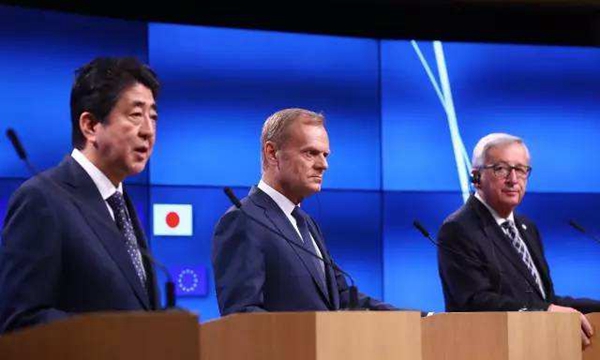EU-Japan free trade pact not yet a done deal
- By George N. Tzogopoulos
 0 Comment(s)
0 Comment(s) Print
Print E-mail China.org.cn, July 17, 2017
E-mail China.org.cn, July 17, 2017
|
|
|
European Council President Donald Tusk (C), European Commission President Jean-Claude Juncker (R) and Japanese Prime Minister Shinzo Abe attend a joint press conference after the EU-Japan Summit in Brussels, Belgium, July 6, 2017. [Xinhua] |
As European leaders endeavor to steer the EU out of economic crisis, they are looking at several ways to boost growth. Discussions on free trade deals – whether successful as in the case of the pact agreed with South Korea in 2011, or unsuccessful, as with the proposed Transatlantic Trade and Investment Partnership (TTIP) during the Obama presidency – are among the most important elements.
The most recent example is an agreement with Japan, with Brussels and Tokyo hailing the initiative announced only hours before the Hamburg G20 Summit, as creating the potential for win-win results in the medium- and long-term.
The EU is Japan’s major trading and investment partner, contributing approximately 10 percent of the latter’s total trade volume, while Japan is the EU’s second biggest trading partner in Asia after China.
Japan’s Europe-bound shipments are dominated by machinery, electrical machinery, motor vehicles, optical and medical instruments, and chemicals, while European exports to Japan principally involve motor vehicles, machinery, pharmaceuticals, optical and medical instruments, and electrical machinery.
The trade volume reached €82 billion in 2014, €90.2 billion in 2015 and €85.9 billion in 2016, with the EU enjoying a surplus moving in a range of €3.1 billion to €5.4 billion during this period.
The process finally leading to a free trade agreement started at the EU-Japan Summit of 2011. Two years later, EU member governments instructed the European Commission to start negotiations with Japan lasting until this month.
Brussels believes its free trade agreement with Japan can follow the example of the Republic of Korea in becoming a beacon of success. According to official data, European exports to South Korea increased 55 percent over the last five years.
The EU is now expecting improved market access for agricultural products in Japan as well as the practical protection of geographical indications such as Tyroler Speck, Munich beer, Jambon d'Ardennes and Polska vodka.
It also seeks to benefit from implementation of non-tariff measures on several products and government procurement by Japan. For its part, Japan mainly counts on the elimination of high tariffs on industrial products and the improvement of regulatory issues facing Japanese companies in Europe.
Yet, the process is still not complete. As the New York Times reports, Japanese negotiators have refused to include whaling and logging in the talks, which have angered environmental groups. Also, the EU and Japan disagree on how future disputes will be resolved as well as on data protection.
More importantly, the forthcoming ratification process is not a simple procedure on the EU side, where the experience of trying to ratify a trade pact with Canada last year shows what can go wrong. Many voices are also suggesting free trade deals only give more power to multinationals at the expense of ordinary European citizens, especially young ones.
From another perspective, politicians and analysts largely view the EU-Japan free trade agreement as a straightforward response to the protectionism of U.S. President Donald Trump. Reuters called it a “political agreement” between two economic entities accounting for a third of global GDP heavy with symbolism.
However, while symbolism is certainly apparent, substance is more debatable. Although the president of the European Commission has played down prospects of any further negotiating difficulties and has said he hoped the treaty could go into effect early in 2019, this cannot be taken for granted.
Both the EU and Japan were perhaps motivated to announce their trade deal due to shared alarm at Trump’s apparent shift away from multilateral open trading systems towards an aggressive “America First” policy. In their effort to do so, they have perhaps overlooked important problems not easily solved. Brussels and Tokyo seem determined to proceed but more time is required.
All in all, it is premature to draw conclusions on the future impact of the EU-Japan free trade deal as long as important details remain unsettled. Influenced by spontaneous enthusiasm, Japanese Prime Minister Shinzo Abe went even further and expressed the hope that the recent announcement could encourage the early enactment of the Trans-Pacific Partnership Agreement (TPP).
As the U.S. alone represents more than 60 percent of the initial members’ GDP, it is questionable whether – after its abrupt withdrawal – the TPP can be implemented despite the ongoing Japanese pressure on the remaining 10 countries involved. It is rather China’s led integration initiative in the Asia-Pacific region that seems more feasible under current circumstances.
George N. Tzogopoulos is a columnist with China.org.cn. For more information please visit:
http://www.china.org.cn/opinion/GeorgeNTzogopoulos.htm
Opinion articles reflect the views of their authors, not necessarily those of China.org.cn.







Go to Forum >>0 Comment(s)